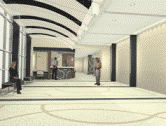
College of Dentistry: Faculty Publications
Document Type
Article
Date of this Version
September 2004
Abstract
Introduction: JET-Fresh™ (Dentsply International, York, PA), a new airpolishing powder that contains aluminum trihydroxide as the abrasive agent, has been introduced for use with Prophy-Jet™ (Dentsply International).
Purpose: The aim of this study was to investigate the surface effects of aluminum trihydroxide airpolishing powder on a series of restorative materials.
Materials and Methods: A total of 6 Class V preparations with enamel margins were created on the buccal surface of extracted human molars. The preparations were restored with Type III gold, a high copper spherical alloy amalgam, porcelain, a lightactivated hybrid composite material, a light-activated microfilled composite material, and a light-activated, resin-modified glass ionomer material. The distal half of each restoration was covered with fiberglass tape and the mesial half subjected to treatment with the aluminum trihydroxide powder via the Prophy-Jet™ for 5 seconds. After removal of the protective tape, the buccal surface of each treated tooth was replicated with impression material. Replicas were generated using epoxy resin and prepared for evaluation with scanning electron microscopy.
Results: The aluminum trihydroxide produced surface alterations that were apparent visually and when viewed by a scanning microscope of the hybrid and microfilled composites and the glass ionomer restorations. The surfaces of the amalgam and gold restorations were altered, but not to the extent that the resin-based materials were. No disruption of the surface characterization of the porcelain was detected; however, with gold and porcelain materials, the aluminum trihydroxide removed notable amounts of the luting cements (the results are consistent with the data gathered with sodium bicarbonate powder).
Conclusion: Aluminum trihydroxide as the abrasive agent in an airpolishing system should be avoided on resin composites, resin-modified composites, and around the margins of cemented restorations.


Comments
Published in Journal of Prosthodontics 13:3 (September 2004), pp. 166–172; doi 10.1111/j.1532-849X.2004.04026.x Copyright © 2008 American College of Prosthodontists; published by Blackwell/John Wiley & Sons. Used by permission. http://www3.interscience.wiley.com/journal/118544241/home